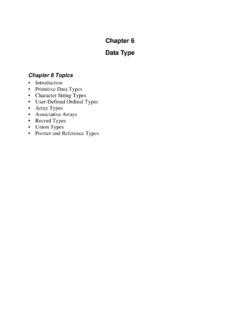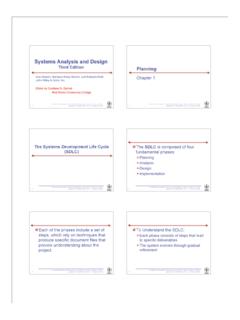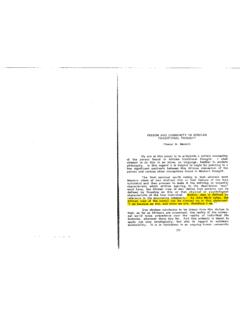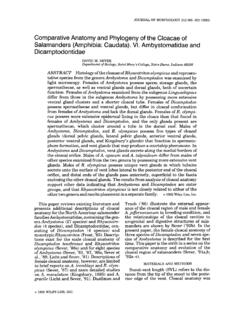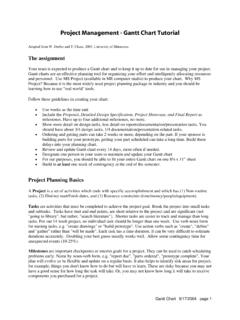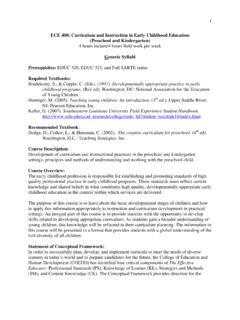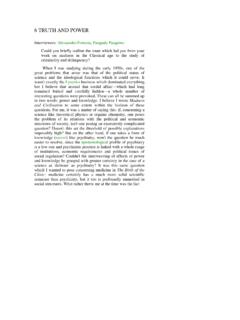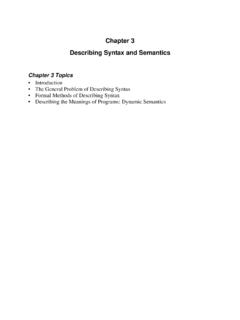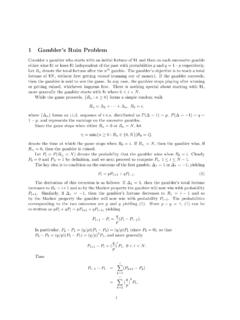Transcription of Chapter 5 Names, Bindings, Type Checking, and Scopes
1 Chapter 5 Names, Bindings, Type Checking, and Scopes Chapter 5 Topics Introduction Names Variables The Concept of Binding Type Checking Strong Typing Scope Scope and Lifetime Referencing Environments Named Constants Variable Initialization Chapter 5 Names, Bindings, Type Checking, and Scopes Introduction Imperative languages are abstractions of von Neumann architecture Memory: stores both instructions and data Processor: provides operations for modifying the contents of memory Variables characterized by attributes Type: to design, must consider scope, lifetime, type checking, initialization, and type compatibility Names Design issues for names: Maximum length?
2 Are connector characters allowed? Are names case sensitive? Are special words reserved words or keywords? Name Forms A name is a string of characters used to identify some entity in a program. If too short, they cannot be connotative Language examples: FORTRAN I: maximum 6 COBOL: maximum 30 FORTRAN 90 and ANSI C: maximum 31 Ada and Java: no limit, and all are significant C++: no limit, but implementers often impose a length limitation because they do not want the symbol table in which identifiers are stored during compilation to be too large and also to simplify the maintenance of that table.
3 Names in most programming languages have the same form: a letter followed by a string consisting of letters, digits, and (_). Although the use of the _ was widely used in the 70s and 80s, that practice is far less popular. C-based languages (C, C++, Java, and C#), replaced the _ by the camel notation, as in myStack. Prior to Fortran 90, the following two names are equivalent: Sum Of Salaries // names could have embedded spaces SumOfSalaries // which were ignored Case sensitivity Disadvantage: readability (names that look alike are different) worse in C++ and Java because predefined names are mixed case ( IndexOutOfBoundsException) In C, however, exclusive use of lowercase for names.
4 C, C++, and Java names are case sensitive rose, Rose, ROSE are distinct names What about Readability Special words An aid to readability; used to delimit or separate statement clauses A keyword is a word that is special only in certain contexts. Ex: Fortran Real Apple // Real is a data type followed with a name, therefore Real is a keyword Real = // Real is a variable name Disadvantage: poor readability. Compilers and users must recognize the difference.
5 A reserved word is a special word that cannot be used as a user-defined name. As a language design choice, reserved words are better than keywords. Ex: In Fortran, one could have the statements Integer Real // keyword Integer and variable Real Real Integer // keyword Real and variable Integer Variables A variable is an abstraction of a memory cell(s). Variables can be characterized as a sextuple of attributes: Name Address Value Type Lifetime Scope Name - Not all variables have names: Anonymous, heap-dynamic variables Address The memory address with which it is associated A variable name may have different addresses at different places and at different times during execution.
6 // sum in sub1 and sub2 A variable may have different addresses at different times during execution. If a subprogram has a local var that is allocated from the run time stack when the subprogram is called, different calls may result in that var having different addresses. // sum in sub1 The address of a variable is sometimes called its l-value because that is what is required when a variable appears in the left side of an assignment statement. Aliases If two variable names can be used to access the same memory location, they are called aliases Aliases are created via pointers, reference variables, C and C++ unions.
7 Aliases are harmful to readability (program readers must remember all of them) Type Determines the range of values of variables and the set of operations that are defined for values of that type; in the case of floating point, type also determines the precision. For example, the int type in Java specifies a value range of -2147483648 to 2147483647, and arithmetic operations for addition, subtraction, multiplication, division, and modulus. Value The value of a variable is the contents of the memory cell or cells associated with the variable.
8 Abstract memory cell - the physical cell or collection of cells associated with a variable. A variable s value is sometimes called its r-value because that is what is required when a variable appears in the right side of an assignment statement. The Concept of Binding The l-value of a variable is its address. The r-value of a variable is its value. A binding is an association, such as between an attribute and an entity, or between an operation and a symbol. Binding time is the time at which a binding takes place.
9 Possible binding times: Language design time: bind operator symbols to operations. For example, the asterisk symbol (*) is bound to the multiplication operation. Language implementation time: A data type such as int in C is bound to a range of possible values. Compile time: bind a variable to a particular data type at compile time. Load time: bind a variable to a memory cell (ex. C static variables) Runtime: bind a nonstatic local variable to a memory cell. Binding of Attributes to Variables A binding is static if it first occurs before run time and remains unchanged throughout program execution.
10 A binding is dynamic if it first occurs during execution or can change during execution of the program. Type Bindings If static, the type may be specified by either an explicit or an implicit declaration. Variable Declarations An explicit declaration is a program statement used for declaring the types of variables. An implicit declaration is a default mechanism for specifying types of variables (the first appearance of the variable in the program.) Both explicit and implicit declarations create static bindings to types .
